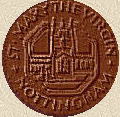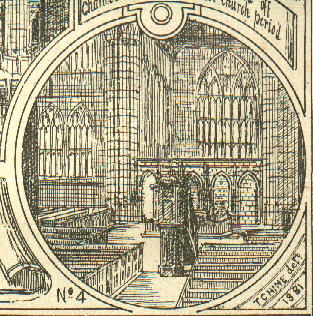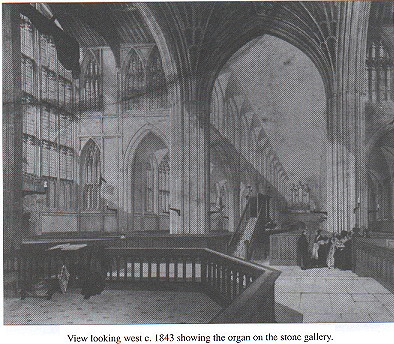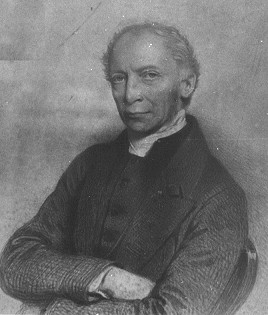 The History of the Parish Church of
St. Mary the Virgin, Nottingham
The History of the Parish Church of
St. Mary the Virgin, Nottingham
The Victorian Restorations, 1830 to 1850 - how did them and how good were they?
After the death of William Stretton in 1828 the influences changed dramatically.
On April 13, 1829, there was the collapse of an immense mass of rock into Narrow Marsh from almost opposite St. Mary's. The Narrow Marsh houses were some "ten to twenty yards" below the bases of the houses on the south side of High Pavement, the part opposite St. Mary's and immediately east of the County Gaol is the highest part. Next to the prison was the warehouse of Mr. Cox, built at the extremity of the cliff, the houses then occupied by Mr. Joseph Pearson and Mr. T.C. Smith stood some yards from the edge, but with land between occupied as gardens running to the cliff edge. Beyond them were premises belong to Mr. Barrows, which also projected to the cliff edge. From Narrow Marsh an immensely high rock and brick wall towered above the houses. When the edge collapsed, starting with that part in front of Mr. Pearson's house, a length fell crushed five houses below; contiguous with the Loggerheads public house (still there). The wall erected to stabilize the rock face bears the date 1829 in coloured bricks.
1829 possibly was the year of installation of gas lamps in the churchyard, (but this may have been the replacement of oil lamps within the town as a whole - public lamps were lit in the Market place on 2 October 1819).
A further fall occurred on March 1, 1830, further west, below the Prison, the wall has the date 1833 in coloured bricks. In April that year, the River Leen in Canal Street, hitherto an open stream, was "arched over".
1830 brought the death of George IV, and accession of his brother, William IV, who reigned until 1837. 1831, thus saw the Coronation of William IV and Queen Adelaide (8.9.1831). This was celebrated in St Mary's, including divine service, the choir was given £5. In October 1831, the ongoing disturbances over the Reform Act became violent, properties damaged included that of Dr. Manson on Stoney Street. Colwick Hall was ransacked and the Castle mansion was set alight. In the next January, a Special Assize tried the ringleaders, Divine Services being held for the Judges in St. Mary's.
1832 saw the first outbreak of "the Asiatic Cholera". It started early in the year, with a case in Lees' Yard, Narrow Marsh. A public fast day was held on 21 March with Divine services being held. In August the epidemic exploded, of a final total of 930 cases, 330 people died before the epidemic ended in November. A new, special cemetery had been opened in Beck Street. This was consecrated as St. Ann's, by the Archbishop of York, on August 27, 1835 .
In April 1832 the Rev. G. Wilkins was appointed Archdeacon of Nottingham. The passage of the Reform Bill on June 14th, was marked by the ringing of church bells, starting with those of St. Mary's.
In 1833, Judges' lodgings were built on High Pavement, the architect being H M Wood, of whom more later.
On August 1, 1834, celebration of the emancipation of slaves occurred, 800,000 in the British colonies this day receiving their freedom. [Note the memorial to James Still, R.N., died off Sierra Leone while on anti-slavery patrol in 1822, in the north aisle]. 1834 also saw the reopening of the much enlarged General Baptist Chapel in Stoney Street. 1835 was the year of first elections to the newly formed Town Council, under the Municipal Corporations Act.
1837 was the year of the accession of Queen Victoria, on the death of her uncle, William IV, and the start of the great Victorian period from 1837-1901. In Nottingham, because of "widely spread distress amongst the operative classes, arising from an utter prostration of the manufacturing interest", a public meeting was held at the Exchange on May 2. Among the speakers was Dr. Wilkins and £5,000 was raised. By the end of the year poverty was severe; within the workhouse were 971 people, 200 men were employed on road building (thus supporting about 1000), a temporary feeding station served over 250 per day, 200 children were fed and educated, 1200 aged, infirm and sick received outdoor relief. The total receiving help weekly was 3629 or about one in fourteen of the population. At the end of 1839, another depression, from the autumn to the following spring, this total was 3481 and £3425 was raised by subscription. Again in the winter of 1841 some £2000 was raised and "expended chiefly in providing soup and bread for several thousand persons in destitute circumstances".
On June 28, 1838, the Coronation of Queen Victoria, was marked with festivities and great celebrations in the town and a Divine Service at St. Mary's. In December, the church was closed for a major internal restoration and services transferred to St. Paul's chapel-of-ease.
1839
This was a major year for the Church. On January 7, a tremendous gale affected Nottingham, and "a great portion of the kingdom". The gale was at its height between 2 am to 6 am and St. Mary's suffered from the flag-staff and one of the pinnacles of the tower being blown away.
 The
Bishop of Lincoln made his first Episcopal visit to Nottinghamshire, and
on September 27th, he "re-opened St. Mary's, after
considerable alterations". According to the Nottingham
Journal (30.12.1842) there were "some alterations in
1839... under the joint direction of Messrs Walker and Mr. Surplice".
Orange, writing in 1840, confirmed that there was a "A handsome
new stone screen, ornamented with decorated shafts, Mr.
Samuel Walker jun., architect" (Pigot's Directory for
1842 lists - Walker, Samuel & Sons, Architects, Toll-House, Derby
Road).
The
Bishop of Lincoln made his first Episcopal visit to Nottinghamshire, and
on September 27th, he "re-opened St. Mary's, after
considerable alterations". According to the Nottingham
Journal (30.12.1842) there were "some alterations in
1839... under the joint direction of Messrs Walker and Mr. Surplice".
Orange, writing in 1840, confirmed that there was a "A handsome
new stone screen, ornamented with decorated shafts, Mr.
Samuel Walker jun., architect" (Pigot's Directory for
1842 lists - Walker, Samuel & Sons, Architects, Toll-House, Derby
Road).
Orange also noted how the tomb with the effigy of Samon upon it, had been "utterly destroyed this spring, being removed to make way for a part of the once lofty and magnificent tomb of the Earls of Clare". The effigy he had as being put upon the north transept altar tomb, "under the canopy". Also put upon that tomb was the marble monument to the memory of Henry Plumptre. Hine noted that the screen was built of Ancaster stone.
In the start of Rev. Wilkins "improvements", for which some £3,000 was raised by voluntary subscription; all old transept galleries removed, a single new gallery of stone built at the west end, when "upwards of 510 extra sittings were gained", the organ was moved to the west end, the altar brought forward to the chancel arch and the archway closed by a stone screen. (Holland Walker described the stone screen as a "brick wall"; Hine had described this as the "First attempt made at a 'restoration'"; Hine's drawing from memory is shown, right). The expensive screen was removed when the tower piers had to be rebuilt in 1842.
 Alexander
Buckingham repositioned and refurbished the Organ, so
that now it was on the loft at the extreme west end (left). The painting
of the Madonna & Child, school of Fra Bartolomeo and
painted ca 1460, was given to the church in 1839.
Originally it was on the east wall to the south of the main altar, then
was removed and left rolled up in the Vestry (see the
Chancel in 1869 before being replaced there (see
1874 view of the Chancel), and
then was moved ca 1885 to where it is today, and given ancient Venetian
frame, ca 1930, cut to fit and presented by Mr. J.A. Simpson.
Alexander
Buckingham repositioned and refurbished the Organ, so
that now it was on the loft at the extreme west end (left). The painting
of the Madonna & Child, school of Fra Bartolomeo and
painted ca 1460, was given to the church in 1839.
Originally it was on the east wall to the south of the main altar, then
was removed and left rolled up in the Vestry (see the
Chancel in 1869 before being replaced there (see
1874 view of the Chancel), and
then was moved ca 1885 to where it is today, and given ancient Venetian
frame, ca 1930, cut to fit and presented by Mr. J.A. Simpson.
On July 1, Royal Assent was given for the enclosing of 29 acres of land south of the Leen, in the old West Croft. This once was part of the glebe land of St Mary's.
1840 saw the marriage of Queen Victoria to Prince Albert of Saxe-Coburg and Gotha. Also that year was the death of Alexander Manson, MD, FRS, at Darley Dale. He had served 13 years in the Royal Navy and then for 30 years as a physician in Nottingham. A memorial can be seen in the south transept, west wall. On April 23, the foundation stone of Trinity Church was laid (Henry Isaac Stevens, architect), opened October 13, 1841. It was financed by middle-class subscription and on newly enclosed land. By 1851 it was the best attended church in Nottingham. After much debate, it was agreed that the Corporation would build a Union Workhouse, at a cost of £17,500, to house 1,150 paupers. This was sited on the "Back Commons" which lay running up to Woodborough Road. During land preparation the site of the long lost ancient church and burial ground of St. Michael, thought to have been demolished in the reign of Edward III (1312-77), was uncovered.
On September 29, 1841, the first stone was laid of St. Barnabas Church, Derby Road, now the Roman Catholic Cathedral. It was consecrated on August 26 1844, by the Right Rev. Dr. Wiseman. The architect was the renowned Augustus Pugin. On December 2, 1851, Dr. Hendren was enthroned as Roman Catholic Bishop of Nottingham.
Desperate Measures
1842 brought chaos to St Mary's, leading to the resignation of the Vicar. On December 18; "Service at St. Mary's was suspended for some months after this date, in consequence of the insecure condition of the tower". The church was closed from December 1842 to April 23rd 1843, then again in October 1843, by Rev. Wilkins, who resigned in the same month, due to frustration at being able to raise the essential money. Essential work was carried out under the eminent architect L.N. Cottingham (see below). An estimate of £3,300 to £4,000 was provided by Cottingham and the tower Pier foundations were strengthened, it having been discovered in December 1942 that the rubble core of the pillars was being pulverized by the weight above.
In January 1843, the Vicar and churchwardens endeavoured to induce the parishioners to grant a rate towards the restoration of the church. It was met at the vestry meeting by the following amendment :- 'That this meeting considers all church-rates as iniquitous and unjust, and therefore decide that this question stand adjourned for twelve months'. The amendment was adopted with 145 voting for an eightpenny rate, and 929 voting for an adjournment.
On August 9, 1843; laying of the corner-stone was laid for the new church of St. John the Baptist, Leenside. The stone was laid by Earl Manvers and an address was delivered to the spectators by Archdeacon Wilkins. On November 14 came the presentation of a testimonial to Archdeacon Wilkins, on his resigning the vicarage of St. Mary's. This was a gift of "an extremely elegant silver teaurn, 115 oz weight, bearing the Rev. Doctor's coat of arms and an appropriate inscription".
On December 4, Her Majesty Queen Victoria , accompanied by HRH Prince Albert, passed through Nottingham en route from Chatsworth to Belvoir Castle. Arriving by Royal train at what became the Midlands Goods Station, they transferred to a carriage and travelled on the new "Queen's Road" across the West Croft inclosure to the "Flood Road", and thence to Trent Bridge.

The south panorama of 1846, complete with steam train. St. Mary's is still clearly dominating its hilltop.
1844
 On
April 6, 1844, Rev. Joshua William Brooks, MA (formerly
Vicar of Clarborough), was installed as Vicar, Patron Earl Manvers. In
1833 Brooks had attended the execution of William Clayton, in front of the
County Gaol and buried in the "upper felon's yard"
(where the inscription over his grave read "W.C., 1833"),
who for a short time had been in the service of Rev. Brooks. Beckett &
Tolley describe Brooks as a man who concentrated on the pastoral care of
his parish (by inference this was not so true of Wilkins), instancing how,
when the church had to be closed, he "proposed carrying on eight
services in the parish weekly", including the licensing of at
least four of the school rooms for services. he also supported the
building of new churches (unlike Wilkins, who had worried about the loss
of income for St. Mary's).
On
April 6, 1844, Rev. Joshua William Brooks, MA (formerly
Vicar of Clarborough), was installed as Vicar, Patron Earl Manvers. In
1833 Brooks had attended the execution of William Clayton, in front of the
County Gaol and buried in the "upper felon's yard"
(where the inscription over his grave read "W.C., 1833"),
who for a short time had been in the service of Rev. Brooks. Beckett &
Tolley describe Brooks as a man who concentrated on the pastoral care of
his parish (by inference this was not so true of Wilkins), instancing how,
when the church had to be closed, he "proposed carrying on eight
services in the parish weekly", including the licensing of at
least four of the school rooms for services. he also supported the
building of new churches (unlike Wilkins, who had worried about the loss
of income for St. Mary's).
On May 20, "A public meeting was held at the Exchange, to adopt measures for the restoration of St. Mary's Church. The Mayor presided. It was stated that, in December, 1842, owing to faulty construction, the piers and pillars supporting the tower began to yield under the immense pressure, and the fall of the tower was only prevented by props and framework, whereby it was temporarily shored up. A public subscription was resolved upon, and in the course of a few months a sufficient sum was obtained to enable the committee to effect a general restoration of the entire structure, including the removal of the incongruous Doric western end and Grecian urn that had been suffered to disfigure it since 1726". A committee was set up under the new Vicar, Rev. Joshua William Brooks. The church was in "a very dilapidated state". Although the church was reopened there were alternative worship arrangements for the next four years.
On June 30, 1845 the General Inclosure Act received Royal Assent. This enabled the enclosure of about 840 acres of the Sand and Clay Fields and the Meadows, 47 acres of the East Croft, and 181 acres of the Forest and Mapperley Hill. Thus began the great outward explosion of the town.
The Scott and Moffatt restorations, 1845-48
The
Scott & Moffatt partnership was appointed to do the vital restoration
work at St. Mary's after the dismissal of Cottingham, who had already
prepared designs. Their tender was selected at a price of £2,800. The
work started at the end of 1845, went on until 1848, and eventually cost
about £7,000. Scott recalled how the work was completed by
Moffatt, presumably after their partnership had been formally
dissolved due to Moffatt's speculation which, ultimately, led him into
bankruptcy.
The works can be located on the Plan
The West front was replaced being restored to what is often described as the original Perpendicular style (close to the 1677 print) but in reality it is an exaggerated and stylized version of the Stretton South front.
The Nave was re-roofed with oak, the corbel angels were restored and the clerestory window tracery replaced. The two western pillars were rebuilt, as also were the four main pillars of the tower. Note that the odd roofline and ornamentation of the east end of the south aisle/south transept parapet predates the 1874 book.
"The stone gallery, originally built in the west front, was removed to the third bay". The Nottingham Review, for 19 May 1848, described how the gallery had "a neat frame at the back, glazed and ornamented".
The organ was repositioned on the floor of the north transept by Alexander Buckingham.
The Tower pinnacles also were replaced - earlier smaller ones had become worn or lost - "one blown down about ten years ago" (see above).
H.M. Wood and the Chancel, 1848
In 1848, the original furnishings of the Chancel were cast aside, the mediaeval stalls being removed and replaced by pews. A roof of "an entirely new pattern" was erected. The Patron, Earl Manvers, met the cost and Mr. H.M. Wood supervised the work. Wylie (1853) recorded that the alabaster carving (now in the south Chapel wall) was found and "the remains of a piscina and sedilia, which had been hidden by a piece of joiner's work behind the altar, were built up". The latter also was reported in The Ecclesiologist (1846, 5). [Note: the Sedilia was found in a church of any size as such was administered by three priests - the Celebrant (Minister), the Gospeller (Deacon) and The Epistoler (Sub-deacon)].
On May 19, 1848 there was a grand "Re-opening of St. Mary's church for Divine service by the Bishop of Lincoln". The total cost was over £9,000. Curiously, the (Nottingham) Date Book records also on June 4, 1850, "Re-opening of St. Mary's church after its restoration".
Summary
Thus, although always acclaimed as such, the reality of the "Scott Restoration" is that Gilbert Scott seems to have made a remarkably small contribution to the church as it stood in 1849. Lewis Cottingham had actually masterminded the key work which saved the church rather than it having to be torn down. The design for the West Front not only slavishly copies the design used by William Stretton for the replacement face of the South transept but also, in so doing, ended up more elaborate than should have been the case for a true restoration back to the relatively austere English Perpendicular. Then, the truth is that the work was supervised not by Scott but by Moffatt. Lastly the unsung hero of the restorations to the Chancel, a not insignificant part of the church, was H.M. Wood.